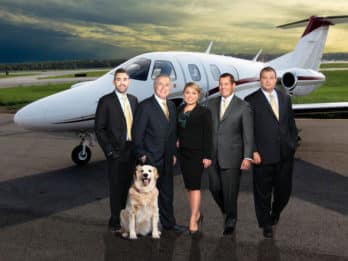The Case of the Boeing 737 MAX MCAS Malfunction Accidents
No lawyer in the world has as much experience with the Boeing 737 MAX control system malfunctions as Arthur Alan Wolk of The Wolk Law Firm.
The crash of Lion Air Flight JT610 is beyond a tragedy for the 189 souls aboard. It is a disgrace.
The Boeing 737 MAX is equipped with a flight control system designed to prevent the crew from accidentally stalling the airplane. It’s called the “Maneuvering Characteristics Augmentation System,” and, in this instance, stall means aerodynamic stall or the airplane quits flying not engine failure.
The incidence of airliner crews accidentally stalling their airplanes is almost non-existent except when in the unlikely event the flight control system malfunctions and misleads the flight deck crew into mishandling the emergency. This occurred over the Atlantic during an Air France Flight to Paris from Buenos Aires some years ago. All aboard were killed so every aircraft manufacturer was on notice that the systems were getting too complex and confusing even for experienced flight crews to master.
Boeing airplanes have traditionally avoided the use of computer interventions which take control of the aircraft away from the flight deck crew and the Boeing 737 MAX is the first time Boeing has departed from that control system design philosophy in the Boeing 737 type.
The MAX system literally uses two Angle of Attack sensors which feeds information to a horizontal stabilizer trim system that will force the nose of the aircraft down if the angle of attack (the angle between a line down the middle of the fuselage and the air it is flying through) gets too steep. This system inexplicably uses only one of the two angle of attack sensors so it has a built-in single point failure in the event that the one it is using fails. The computer senses that at that angle even if incorrectly measured due to a malfunctioning angle of attack sensor, the airplane is approaching or will approach stall and trims the stabilizer nose down to prevent the aircraft from stalling.
The problem is that the system won’t allow the crew to disable it in a timely way if at all and it will take control away from the crew all the way into the ground or ocean. In fact, since the system only works when the airplane is in manual flaps up condition, lowering the flaps would have disabled it … but nobody in the cockpit knew that because Boeing didn’t tell them.
In the instance of the Boeing 737 MAX, there was nothing in the FAA-approved flight manual to advise the crew of this anomaly or how to deal with it and nothing in the differences training (the training of flight deck crews in one type of B-737 to know what’s new or different about the MAX) to cover it. Therefore the Lion Air crew was stuck between the proverbial rock and a hard place trying to figure out what was wrong and what to do about it.
There is no question that Boeing knew about the issue and the potential failure mode because it designed and built the system. It was obligated to create a Failure Modes and Effects Analysis so the various potential failures could be addressed. It also knew it had a responsibility under the Federal Aviation Regulations to design the system so it could be flown by pilots of ordinary piloting skills, without the use of excessive strength and the system must be able to be overridden by the crew using ordinary-strength and easily disabled if it malfunctions.
Boeing was required to supply the FAA with a Flight Manual, that only the FAA can approve, which gives the crew all the necessary information to deal with emergencies and abnormal conditions and under no circumstances is one emergency allowed to create an even wors emergency. Clearly, the FAA didn’t read it, didn’t understand it, didn’t flight test it and just rubber-stamped it.
This Maneuvering Characteristics Augmentation System was malfunctioning on four flights before the accident flight. The flight deck crews reported the malfunctions and Lion Air maintenance people claiming they used the manuals that Boeing supplied, troubleshot the squawk, and claim they fixed the system as instructed. The problem is that this malfunction could not be effectively troubleshot on the ground as the angle of attack sensors typically fail in the air. That’s why each succeeding flight deck crew had the problem again. In addition, the system cannot be effectively troubleshot by the methods the maintenance personnel was given in continuing airworthiness manuals that Boeing was required under the Federal Aviation Regulations to provide with all means necessary to maintain the aircraft safe for flight.
Many other types of jet aircraft have a single switch that will allow the crew to disconnect the entire trim system. But because this was a stall protection system, often the means to disable it is more complicated so the protection is not lost. Clearly the crew of Lion Air JT610 was unable to disconnect or disable the system and the nose was pitched down in ever-increasing amounts such that even tugging as hard as they could the crew could not overcome the dive to eventual oblivion. The very fact that the crew could not disable or override the system makes the system itself a violation of the same Federal Aviation Regulations.
Arthur Alan Wolk litigated the Boeing 737 MAX rudder malfunction accidents, United Flight 525 in Colorado Springs, Co. and USAir Flight 427 in Aliquippa Pa., for nine years successfully settling the cases of the many passengers he represented after proving, in spite of Boeing’s denials, that the rudder control system was flawed. It has since been redesigned. Wolk proved the rudder control system defective not only to the NTSB which was mesmerized for years by Boeing’s denials but to Boeing and its insurers as well.
The rudder in the Boeing 737 MAX also had a single point failure and there was no mention of a procedure to counter it in the FAA-approved Flight Manual. The regulators don’t regulate and the manufacturers do not comply with the regulatory requirements.
No one is more qualified to litigate Lion Air JT 610 than Arthur Alan Wolk and The Wolk Law Firm. Arthur Alan Wolk can be reached at the office 215-545-4220 or on his cell 610-733-4220.




